Tagged with 'London'


-
Pearls Exhibition at the V&A Museum
Pearls Exhibition at the V&A Museum
With much excitement and anticipation, the Pearls exhibition at the V&A Museum opens later this month in London.
PEARLS EXHIBITION AT THE V&A
Promising to be one of the biggest Autumn shows, the exhibition will show off the luxurious qualities of some of the world's most unusual and valuable pearls and jewellery, as well as exploring the unique heritage and impact on popular culture of this beautiful gem.
We are very fortunate to be able to ask Beatriz Chadour-Sampson and Hubert Bari, the curators of the Pearls exhibition, about the show and what a visitor can look forward to. We would like to thank them, the V&A and the Qatar Museums Authority for their support with this article.
Here are Beatriz and Hubert's thoughts on 'Pearls'.
How special has this exhibition been for you and to curate? What did you hope that its visitors may learn about pearls?
From all gems, it is the most unusual as the natural pearl is produced by living animals. Even cultured pearls after human intervention are created by nature. Visitors will be amazed to learn that, in principle, any mollusc can produce a pearl from the giant clam to the land snail, and they will be dazzled by the variety of shapes and colours of pearls.
The history of the trade of pearls between continents is fascinating, and how East and West share the same passion for pearls.
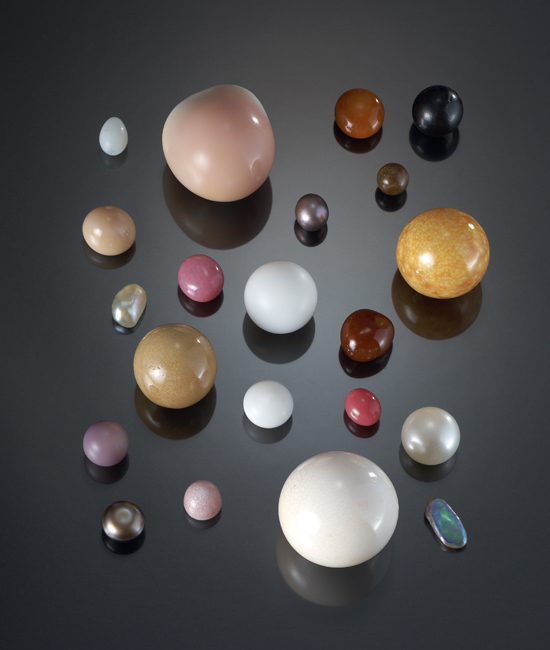
Pearls have a unique symbolic significance and mystique. Can the pearl claim to be the world's favourite gem?
Incredibly, pearls have created a global fascination over millennia, like no other gem. There is something magical about pearls, their beauty lies in their perfection of form and most of all lustre. They are born in the form that nature made them with a natural sheen.
Pearls have always been a symbol of femininity. Maybe this is the reason why the fashion for pearls continues today.

The exhibition showcases many famous examples of pearl jewellery, many styles of which are still being referenced today in popular culture. Have we already seen a 'golden age' of pearl jewellery design or is the pearl a gem that will be constantly reinvented?
Yes, as no other gem has been worn as consistently, as pearls. Pearls are neutral and versatile, appropriate for any occasion. In previous years jewellers have shown a persistent, if not renewed interest in creating new designs with pearls.

What is the most striking or surprising aspect for you about the history of the pearl?
The fascination for pearls and wish to wear these beauties of nature transcends cultures and borders. The similarities in the myths and legends surrounding the pearl in East and West are astonishing. Pearls mark authority and power, symbolize prosperity and on a more personal note they are associated with joy at weddings or tears as a sign of mourning.

Natural pearls have undergone a renaissance in the last decade, achieving spectacular prices at auction, and cultured pearls are being produced in better, more diverse and beautiful qualities. What does the future hold for this gem?
The future of the pearl depends on so many factors, not least the condition of our seas. Natural pearls are simply too rare and expensive, only affordable to the very few. Today China produces such quantities of cultured pearls of inferior quality, that they are endangering the pearl market. Whilst they give great care when creating one pearl from an oyster, the Chinese produce 50 in one mussel, at low cost in rice fields or near housing estates. In South East Asia the farms which produce the beautiful South Sea pearls are experiencing not only financial difficulties but the effects of pollution and for these reasons their future remains uncertain.
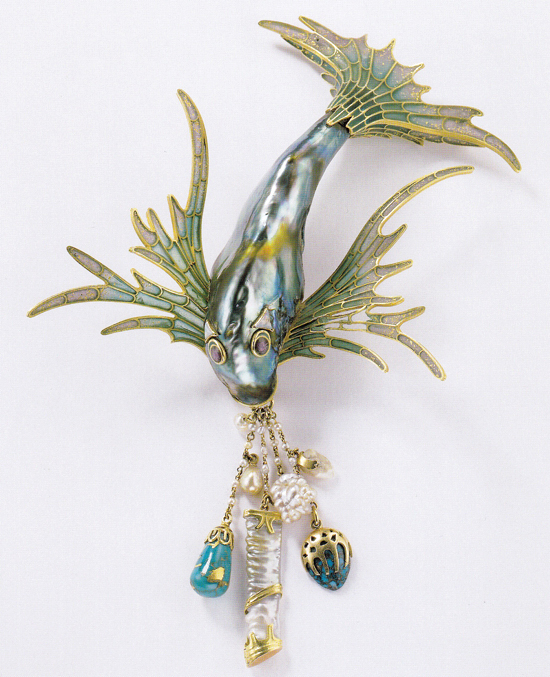
The desire for pearls has been so insatiable that imitation pearls have existed over centuries and their advocate in the 1930s Coco Chanel was instrumental in reviving the fashion for pearls and revived the industry at a time when this was unthinkable. No one can tell what the future will hold for this beautiful gem, but the fashion for pearls endures.
The 'Pearls, V&A and Qatar Museums Authority Exhibition', runs from 21 September 2013 to 19 January 2014 as part of the Qatar UK 2013 Year of Culture.
To learn more about the exhibition, visit the V&A website here.
-
CSM Jewellery 2013 - The Designers Part II
CSM Jewellery 2013 - The Designers Part II
The second in a two part series of short interviews with designers from the CSM Jewellery 2013 show features Natha Khunprasert, Ruth Mackin, Sarah Ysabel Dyne Narici and Xue Dong.
Read about some of the other designers in Part I of our interviews here.
NATHA KHUNPRASERT

Tell us a bit about yourself.
I grew up wanting to be a fashion designer, and then find my interest in product design to then ultimately realise my true passion lies within jewellery designing and making. I enjoy injecting kitsch element into my work.
What was the inspiration for this piece?
The initial inspiration of my collection projected from my personal interest in the beauty and function of nails, as personal expression of style and extension of our bodies. The project developed into not only the jewellery for nails but instead, jewellery about ‘Fingertips’, where they play significant roles in our lives.
Who is your favourite designer or artist and why?
Melanie Georgacopoulos: I truly admire her ability to give an edge and a more youthful & playful aesthetic to the timeless value of pearls, as well as her talent in creating both equally exciting smaller pieces and big show pieces.
What’s your motto?
“Live life to the fullest”
RUTH MACKIN
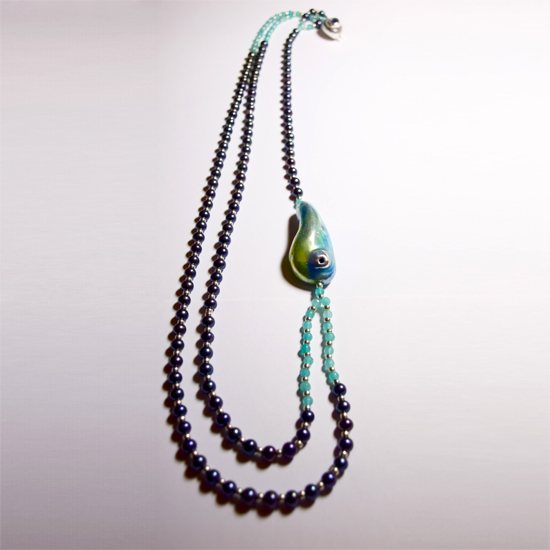
Tell us a bit about yourself.
My name is Ruth Mackin and I was born in Vanuatu in the South Pacific. My family and I later moved to the Cayman Islands returning to Britain for my secondary education. Arts Foundation was great fun at Chesterfield College, then on to CSM. I love creating miniature detail in my creative work and hope this shows through in my design process.
What was the inspiration for this piece?
Fond memories of tropical seas and the brilliant colours of the ocean. Even now watching the ebb and flow of the tides as they sweep through rock pools. Feeding sea anemones tiny scraps of fish.
What’s next for you?
I spent a very varied and exciting internship between second and third year working for Hannah Martin (London) and various other companies. Now I want to successfully complete my degree and move forward with designing collections within a company, perhaps one with connections on the continent, hence the French lessons.
Name one jewellery toolbox essential that you can’t live without.
My paints and paint brushes.
SARAH YSABEL DYNE NARICI

Tell us a bit about yourself.
I am a half Italian, half British twenty-two year old female. I grew up in Milan until I was nine years old… I have been studying jewellery design at CSM for three years and am ready for the next chapter of my life to commence!
What was the inspiration for this piece?
The collection is designed for a future society, living outside of planet Earth’s parameters in the year 2050. The pearls in these pieces have been encapsulated into individual acrylic blocks in a nostalgic act of celebration of the natural wonders of the Earth.
What’s next for you?
After I graduate I plan on moving to Paris to expand my knowledge of design in a fine jewellery house.
What do you like most about pearls?
The stunning and subtle array of colours that you can see on closer inspection.
What has been your best experience or moment at CSM?
Difficult to answer there have been many! Finding a path that I enjoy so much is probably the best feeling and experience I have had.
Who is your favourite designer or artist and why?
This is difficult to answer as I have many, however one of my favourites is the Belgian multidisciplinary artist, Jan Fabre. I think he is one of the most exciting contemporary artists and his work both in theatre and sculptures always prompts question and thought.
If you were a gemstone, what would you be?
An opal.
Name one jewellery toolbox essential that you can’t live without.
My file.
What’s your motto?
"Audentior ito"
XUE DONG

Tell us a bit about yourself.
I think jewelry is like small sculptures. I am interested in making jewelry, which is delicate with less formally structured shapes.
What was the inspiration for this piece?
My inspiration comes from the cloud. I love the cloud’s irregular changing shape and changing colors in different weather conditions.
Who is your favourite designer or artist and why?
I was influenced by Tara Donovan’s sculpture, I really like the way and feeling she created the fabulous structure.
What’s your motto?
"Be structural, romantic, fluency" -
CSM Jewellery 2013 - The Designers Part I
CSM Jewellery 2013 - The Designers Part I
In addition to the prize-winning work by Bella Mung (pictured above), there were many other surprising, innovative and creative uses of pearls in the CSM jewellery 2013 degree show this year.
Here we feature the first in a two part series of short interviews with designers from the CSM Jewellery 2013 show, including in this article - Beatrice Bongiasca, Claudia Rice and Emily Wright.
Read about some of the other designers in Part II of our interviews here.
BEATRICE BONGIASCA
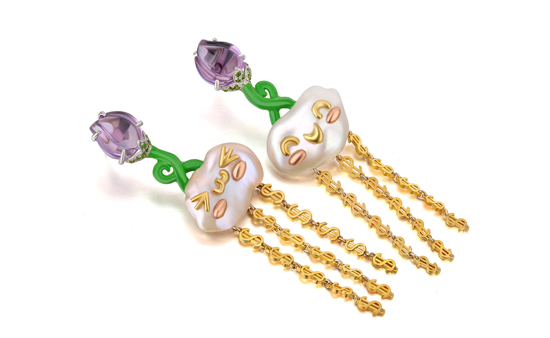
Tell us a bit about yourself.
My name is Beatrice and I am from Milan, but I have been studying BA Jewellery Design at Central Saint Martins in London for the last four years. I am very lucky to have found my passion so early in life because it truly is what I want to do in my life.
What was the inspiration for this piece?
My final collection ‘The Western Orient’, which was inspired by the increasing importance of the Asian market in today’s society, is a merge between the Orient’s heritage and the West’s strong consumer capitalist culture. The motifs embedded within the jewellery hold symbiotic connotations which function as a social critique of the globalisation in Eastern Asia.
This piece in particular is based more on the Western aspect as it focuses on the phenomenon of conspicuous consumption by means of stating the ‘price’ on the pearls.
What do you like most about pearls?
I like how timeless and elegant pearls are and the contrast that they create in my work, which uses very contemporary imagery. The pearls in my collection make my jewellery look more refined as they give it a lustrous classic undertone.
What’s your motto?
"Dream big"
CLAUDIA RICE
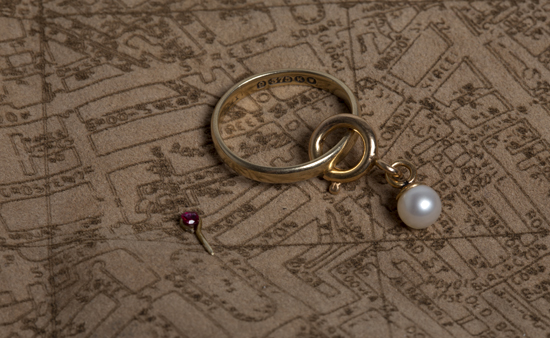
Tell us a bit about yourself.
My name is Claudia Rice and I have come into the craft of jewellery making and designing from having my father (and his father) in the jewellery business all his life as my influence. Starting as a watchmakers apprentice at 15, he was a traveling salesman for Mikimoto and Rosita Pearls during the 70s, setting up workshop in Hatton Garden to having his own shop in Marylebone high street, where I spent a lot of my time.
These surroundings have fed my desire to be part of that and continue my family trade.
What was the inspiration for this piece?
My inspiration stemmed from research into my dissertation on the subject of The History of Hatton Garden and my family connection with it. Becoming intrigued by maps of old London, discovering locations of ‘hidden treasures’, using an A-Z from 1969 and making a link with the modern technology of Google Maps.
What has been your best experience or moment at CSM?
Winning a design award from the Worshipful Company of Tin Plate workers.
What’s your motto?
“What goes around…”
EMILY WRIGHT

Tell us a bit about yourself.
I am a quietly confident person, I enjoy being creative and I don’t work well under pressure!
What was the inspiration for this piece?
The theme for my collection is reconnecting with those we have lost, through every day gestures, such as the simplicity of placing a necklace on a loved one.
What’s next for you?
Graduating (hopefully) and going into the world of work.
What do you like most about pearls?
I love the simplicity of pearls, they are glamorous in a beautiful yet understated way.
What has been your best experience or moment at CSM?
I have enjoyed the opportunities CSM has provided, and the opportunities we have had that we wouldn’t have gotten anywhere else.
Who is your favourite designer or artist and why?
I love the sculptures of Barbara Hepworth, I love the simplistic designs and the perfection in the lines.
What’s your motto?
"The best things in life aren’t things."
-
Five Minutes with Caroline Broadhead, CSM
Five Minutes with Caroline Broadhead, CSM
We recently announced a very special collaboration in Pearls with the BA Jewellery Design course at Central Saint Martins (CSM), the creative arts institute of the University of the Arts London.
This week sees the start of the second set of degree shows at CSM, which are a celebration of design and the final year students' work. Later this week, we will also be announcing the winner of our prize for the Best Use of Pearls amongst the final year Jewellery students.
Here, we take five minutes with Caroline Broadhead, who is the course leader at CSM, to ask for her views on jewellery and pearls.
Caroline's own work in jewellery has explored the use of textiles and developing her work into garment form. She has exhibited extensively in the UK and internationally, including recently in the Unexpected Pleasures contemporary jewellery exhibition at the Design Museum, London.
Tell us a little about yourself and your role at CSM?
I am Course Leader, which means I have responsibility for the overall direction and management of the 3 year course. I also teach across the years, though mainly I am involved with the final years, along with the Year 3 tutor, Lin Cheung.
What does ‘jewellery’ mean to you?
Jewellery can be superficial or significant; an accessory or fundamental; mean nothing or everything. The subject can be interpreted widely, as it represents what we value.
It can be a spatial, formal construction relating to the physical body; as something worn close to the body it can relate to the emotions; it can indicate our relation to materials and what we do with them; it can be the means of expressing identity and reading that of others.
What influences have inspired you in your own design, can you give us an example?
A very obvious example was when I travelled to Africa in the late 70s and saw Masai jewellery being worn, colourful, bold designs that dominate the body. I also observed the women weaving baskets in the markets and both those came together later in woven nylon work. Other than that, it is a combination of a lot of different things.
What should come first in design - material, form or function?
I think that the best designs are those where these work together. Some people start from a particular material, shape or function and take it from there, but everyone has a different process and there is no failsafe formula.
What trends in current jewellery design do you like the most and least?
I am very supportive of the growing awareness of ethics and sustainability in the jewellery world.
What do pearls mean to you?
They are beautiful and organic.
What are the opportunities today for using pearls in jewellery design?
A string of pearls is an iconic piece of jewellery and pearls, as such, are ripe for experiment and questioning to extend their potential.
What are the main challenges for a new jewellery designer starting out?
Gaining the relevant experience of how to run a business is something that takes time and it is easy to make expensive mistakes. Each person has to find out what the appropriate context is for their work and how best to promote, sustain and develop it.
What is the best advice that you give to your students?
Have faith in yourself, don’t stop working.
What is your favourite part of the working day?
The first bit, when I feel I can get through all the things on my To Do list!
-
Erwin Blumenfeld at Somerset House
Erwin Blumenfeld at Somerset House
Just opened at Somerset House, London until 1st September is a celebration of the work of Erwin Blumenfeld, one of the most innovative fashion and advertising photographers of the twentieth century.
Featuring over ninety restored and coloured corrected prints of his work, the Blumenfeld Studio exhibition tells the extraordinary story of Blumenfeld's journey behind and in front of the lens.

Born in Berlin in 1897, Blumenfeld was given a camera at the age of 10 by his uncle, a gift that was to help shape his future life.
The young Blumenfeld experimented from an early age with the technical aspects of photography, using innovative darkroom techniques, solarisation and multiple exposures to develop his own trademark style - without the current temptations of Photoshop.
He initially focused on portraits and the nude female form, influenced in part by the work of Man Ray and the free expression of the Dadaist movement. The use of mirrors, silk, elaborate shadows, abstraction and angles also contributed to his work becoming noticed.
Moving to Paris in 1936, Blumenfeld was introduced by Cecil Beaton to French Vogue and was given a year's contract to work for the magazine.
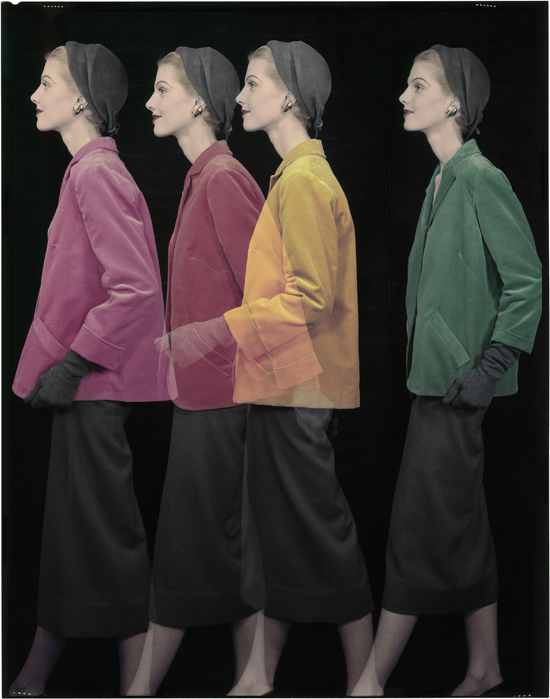
Following the outbreak of Second World War, and a period of internment, Blumenfeld successfully fled France with his family for America.
Fashion photography for Harper's Bazaar, Vogue and advertising campaigns for Elizabeth Arden, Dior and L'Oréal followed, securing Blumenfeld a near legendary reputation.
Even today Blumenfeld is known as the photographer for having the most Vogue covers, an achievement all the more remarkable for his persistence in refusing to compromise with the magazine's picture editors.
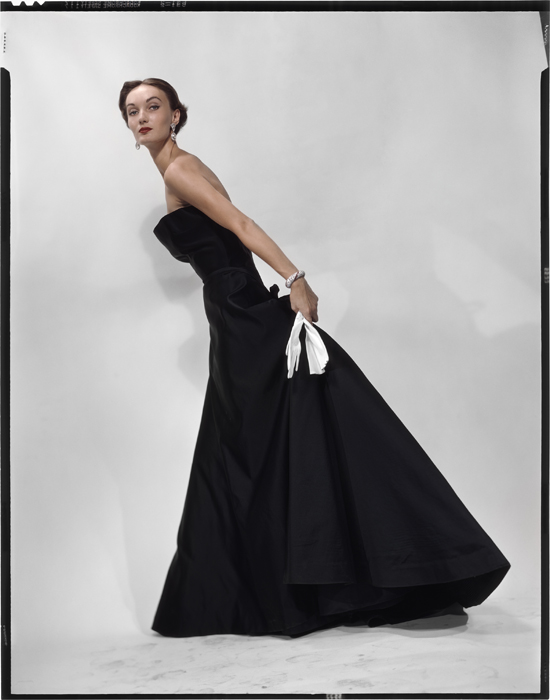
Celebrity models such as Grace Kelly and Audrey Hepburn contributed to the glamour, but the exhibition images demonstrate that throughout Blumenfeld continued to develop his work.
The confidently striking picture of a single eye, a beauty spot and a perfect pair of red lips for Vogue's March 1950 edition would be unknown on the front covers of today's magazines.
In a fitting tribute to Blumenfeld for Chanel, the Norwegian fashion photographer Solve Sundsbo commented "Blumenfeld was shooting 60 years ago what the rest of us will be shooting in 10 years time”.

Blumenfeld passed away in 1969 in typically unconformist style, believed to have deliberately forced a heart attack on himself by running up and down the Spanish Steps in Rome.
Following his death, an archive of some 8,000 prints were shared between his assistant and three children. Many of these have recently been faithfully restored and digitally mastered.
Blumenfeld left a stunning, much-copied and admired body of work that is surely as inspiring today as it was pioneering in the 1940s and 1950s.
-
Central Saint Martins and Pearls
Central Saint Martins and Pearls
We are delighted to announce a very special collaboration in Pearls with the BA Jewellery Design course at Central Saint Martins (CSM), London.
Central Saint Martins ranks amongst the most influential arts institutes in the world. It has the reputation for being the home of creativity. The College exists to generate knowledge, to inspire creativity and develop the next generation of ambitious designers, artists and performers. CSM attracts the world’s most talented students. Drawn from over 90 countries the students represent some of the world’s most exciting raw talents.
What will we be doing with CSM this year?
Firstly, we have been working with a selection of Year Three BA Jewellery Design students so that they have a fantastic opportunity to be given free rein to produce a stunning piece of jewellery using pearls. With our own heritage of over 50 years of knowledge and experience of working with pearls, we hope this collaboration will be a great experience for these soon-to-be graduates.
In June, Winterson will be awarding a prize for the Best Use of Pearls at the Jewellery Awards evening on 20th June 2013 during the Central Saint Martins degree shows.
Secondly, the Year One BA Jewellery Design students at CSM are working in conjunction the upcoming Pearls exhibition to be held at the Victoria and Albert Museum (V&A), the world famous museum of art and design, in the Autumn later this year. The exhibition explores the history of pearls from the early Roman Empire through to the present day, the beauty and allure of pearls which across centuries and cultures have long been associated with wealth, royalty and glamour.
Following an introductory talk by the exhibition's curator Beatriz Chadour, the students will be investigating the historic and cultural significance of pearls and their contemporary relevance and versatility. In addition they will be given a handling session at the V&A and experimenting directly with pearls in the workshops.
We will also be supporting these students with a range of pearls to work with. The results will be shown at the V&A on the Pearls exhibition Study Day, alongside a How to Wear Pearls event, which the students will be hosting.
It's a truly great privilege to be working with these two highly respected institutions of design.
Follow our Journal or Facebook page to keep up to date with how the collaboration develops this year.
-
Contemporary Jewellery at the Design Museum
Contemporary Jewellery at the Design Museum
Unexpected Pleasures is a new exhibition on contemporary jewellery at the Design Museum London, celebrating the art of the unconventional.
Delicate and sophisticated designs, precious gemstones set in an elegant setting of silver or gold, a form of adornment - these are the accepted forms of jewellery today.
The contemporary jewellery movement was born in the 1970s to highlight the notion that jewellery is as much about our emotional attachments and response to jewellery, as well as about its financial value. Many of the exhibition's 200 pieces chosen from around the world will certainly make you smile, be surprising or perhaps just elicit a yawn.
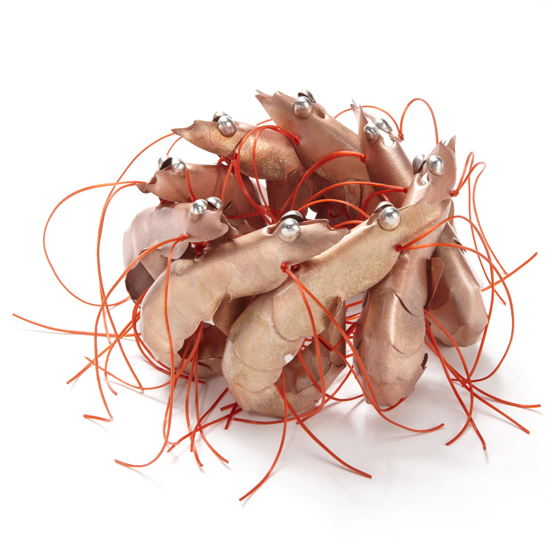
Whatever your reaction, exhibits such as the Scampi Bracelet by David Bielander above or the Yellow Kelly pendant necklace by Felieke van der Leest below show that contemporary jewellery can successfully challenge our views of what can defines and makes jewellery.
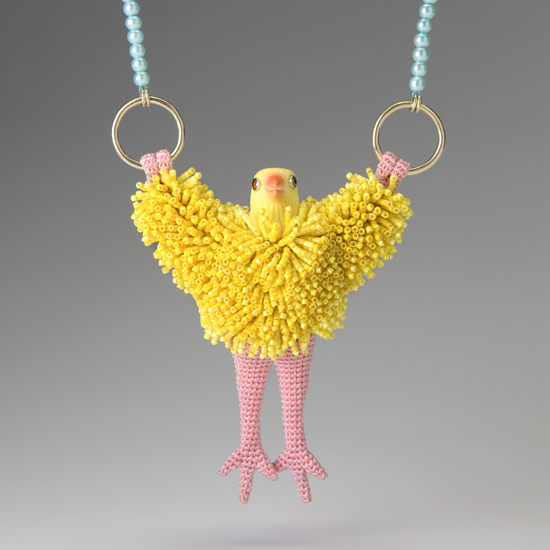
Curated by jeweller Susan Cohn, there are three main themes to the exhibition examining how we experience wearing jewellery, the meaning and narratives that are expressed in the jewellery that we wear and a perspective on the origins of present day jewellery trends.

The contemporary jewellery presented is discreet, pretty and poetic at times, whilst being loud, wild and completely unwearable at others. True to the unconventionality of the jewellery, the materials chosen are also rarely valuable as is the case with this ring of rusty nails and screws by Karl Fritsch above or the necklace of vibrantly colourful Paper Pearls by Dutch artist Mano van Kouswijk.
Amongst the jewellery pieces displayed was this woven fine nylon Veil (1983) by British artist, and Course Director of BA Jewellery at Central St Martins, Caroline Broadhead. Reminiscent of a screen, the flexible Veil explores the space of the wearer and the ability of the wearer to look through it.
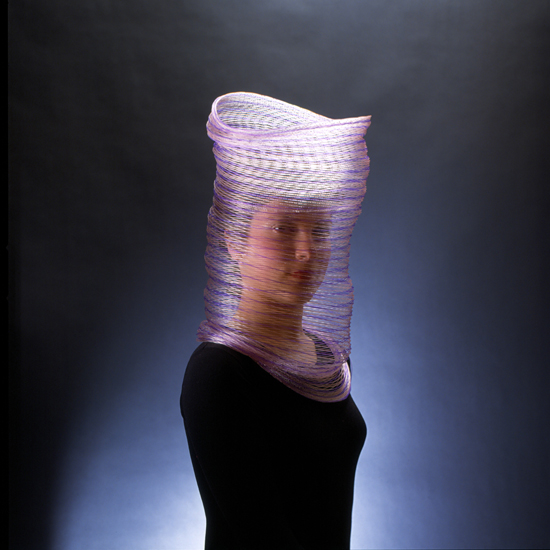
The exhibition does push the traditional jewellery lover into a nearly uncomfortable place. Are these designs valuable pieces of jewellery or just art? Perhaps the unexpected pleasure of this exhibition is not just the surprising exhibits, but the questions it raises too.
Unexpected Pleasures: The Art and Design of Contemporary Jewellery at the Design Museum, London is open until until the 3rd of March 2013.
-
Tim Walker: Story Teller at Somerset House
Tim Walker: Story Teller at Somerset House
Tim Walker: Story Teller is a new exhibition at Somerset House, London. What would fashion, a love for beautiful clothes and accessories be without the magic of photography?
Vogue has promoted fashion through its illustrations and photography since the foundation of the magazine in 1891. Amongst the most exciting fashion photographers today, Tim Walker has been working with the influential magazine for nearly 20 years.
For another two weeks until 27 January 2013, a selection of Tim Walker’s most exceptional photographs are being presented in a stunning exhibition at Somerset House, London.

Image 1: Karlie Kloss and broken Humpty Dumpty, Rye, East Sussex, 2010
Image 2: Olga Shearer on blue horse, Sennowe Park, Norfolk, 2007
Born in 1970 in England, Tim Walker started taking photographs as a teenager and at the age of 25 published his first fashion story for Vogue. The work of Tim Walker is in a way quintessentially British, with originality, eccentricity and humour.
The images are filled with wonder and fantasy as Tim Walker presents fashion in the context of magical sets, inspired by legendary fairy tales. The 175 photographs may be deceptively simple or elaborately staged using unusual props such as a monstrous giant doll or a life-size Spitfire crashing through a room. In every case, the photograph tells a story.
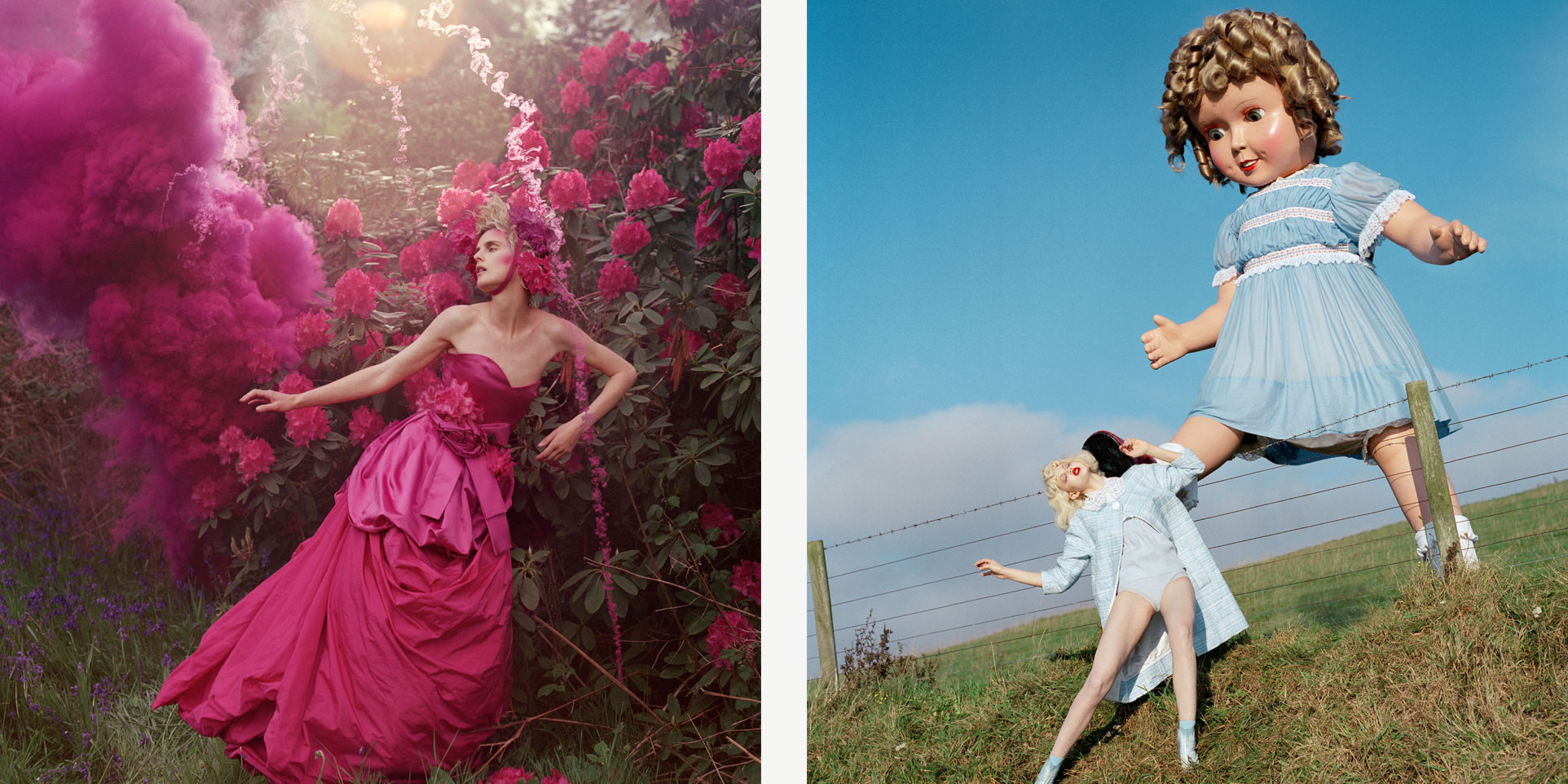
Image 1: Stella Tennant and pink powder cloud, Eglingham Hall, Northumberland, 2007
Image 2: Giant doll kicks Lindsey Wixson, Eglingham Hall, Northumberland, 2011
This romantic and extravagant style has attracted some of the biggest names in fashion. As well as working on the advertising campaigns of Mulberry, Hermès and Valentino, in recent years Tim Walker has succeeded in shooting some extraordinary images of Marion Cotillard, Kate Moss, Alexander McQueen and Helena Bonham Carter.
Despite this, Walker says the camera "is simply a box put between you and what you want to capture".
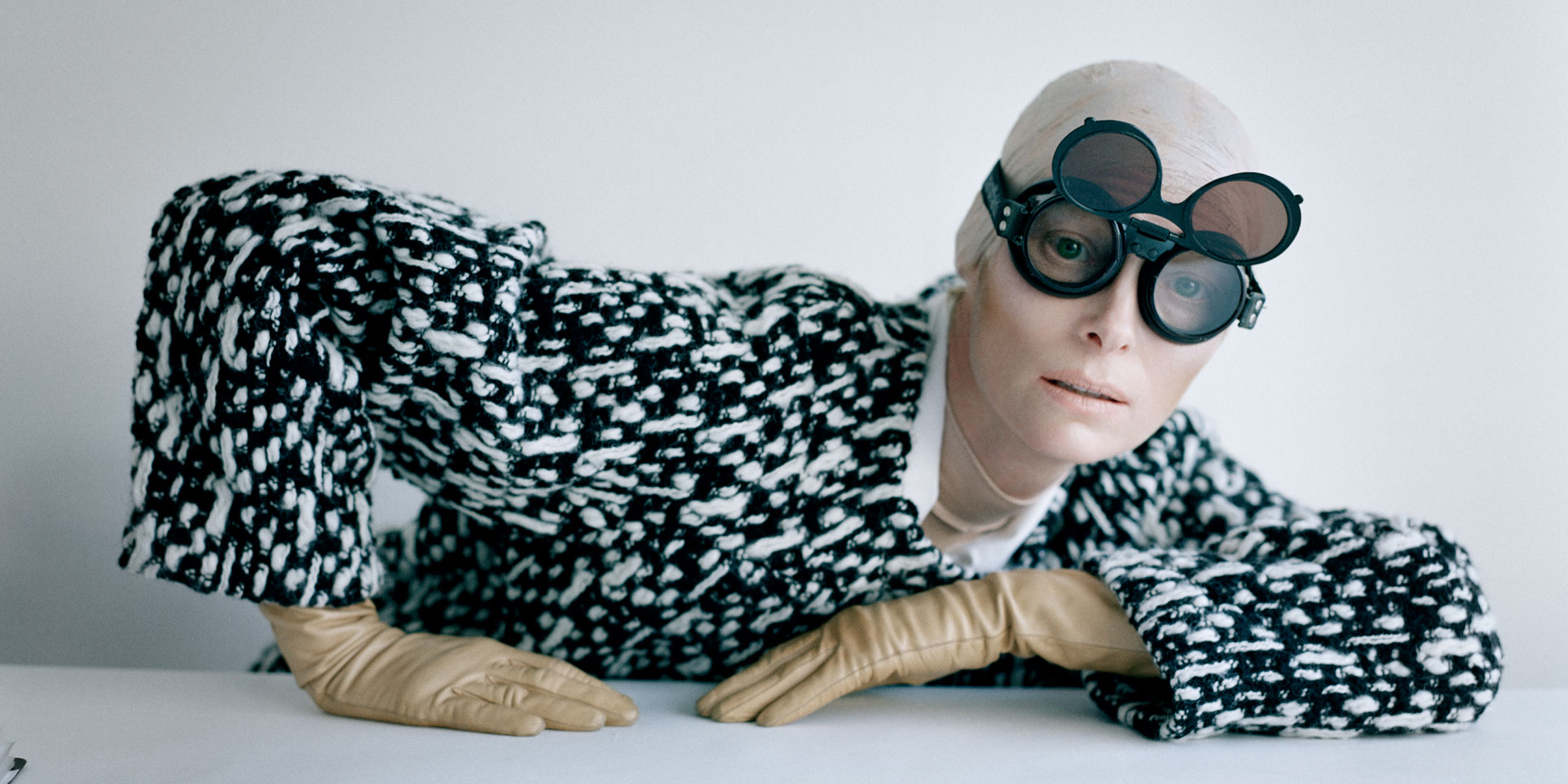
Image: Tilda Swinton and aviator goggles, Reykjavik, Iceland, 2011
The fabulous images exhibited at Somerset House include Xiao Wen & Lui Wen dressed as samurai nuns, Karlie Kloss shocked at a broken Humpty Dumpty, Olga Shearer on a dreamlike blue horse, Tilda Swinton in aviator googles and Malgosia Bela with five gravity-defying guardsmen.
If you are unable to visit the Tim Walker: Story Teller exhibition at Somerset House this month, a number of Tim Walker's photographs can also be viewed in the permanent collections of the National Portrait Gallery and the Victoria & Albert Museum, London.
Or take a journey and wander into the fantasy world of Tim Walker. -
Chanel's Little Black Jacket in London
Chanel's Little Black Jacket in London
Chanel is celebrating and revisiting its iconic little black jacket with a photographic collaboration between the fashion house’s head designer and creative director, Karl Lagerfeld, and former editor-in-chief of Vogue Paris, Carine Roitfeld.
Photographs taken by Karl Lagerfeld of 109 models and celebrities wearing the little black jacket are captured in a book and displayed in a touring exhibition, which is currently being hosted by the Saatchi Gallery in Chelsea, London until November 28, 2012.
Karl Lagerfeld explains “The Chanel jacket is a man’s jacket, which has become a typically feminine piece. It has crossed that boundary. It has become the symbol of a certain feminine elegance, nonchalant and timeless."
In the spacious exhibition rooms of the Saatchi Gallery, the portraits wonderfully show off the varied looks and styles of the little black jacket. Carine Roitfeld explains “It is an easy piece, you can do a lot with it. You can wear it with jeans, over an evening dress, you can see it on a ballet dancer. It suits everyone, it is an incredible piece. It is almost like a jean jacket, but very elegant.”
Certain photographs stand out, in particular a profile of Tilda Swinton, a shot of Anna Wintour with her iconic hair bob facing away from the camera, and Carine Roitfeld herself, wearing drapes of long pearl rope necklaces.
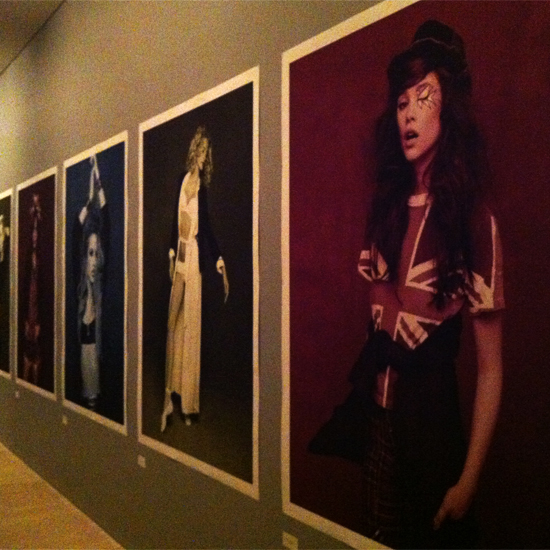
Under the creative drive of Karl Lagerfeld, the fashion house is still setting a trend. Earlier this month, Chanel displayed a spectacular Spring Summer 2013 fashion show in Paris at the Grand Palais. The stadium sized floor plan had photovoltaic-effect flooring and lines of majestic wind turbines rotating gently and synchronously as the models wandered the spectacular catwalk.
The Spring Summer 2013 collection beautifully captured the fashion house's founding attributes of simplicity, luxury and reserve. The collection included Chanel’s black and white colours, but was also lightened with unthreatening reds, blues and greens. The love of Chanel for pearl jewellery was reinvented into bold bundles of oversized faux pearls worn as choker necklaces and bracelets. Also in the collection, pearls of small or larger sizes were scattered across skirts and jackets in the form of patterns or more functionally presented as buttons.
Bringing together the arts, with fashion, jewellery design, and photography, the little black jacket exhibition is an alternative, but nonetheless inspiring look into Chanel's unique world.
-
Jewellery at London Fashion Week 2012
Jewellery at London Fashion Week 2012
London Fashion Week 2012 (LFW) just closed its doors after five days of exciting and creative activity, with new fashion collections being presented to buyers for the Spring / Summer 2013 season. For the second time, the Rock Vault at LFW also showcased some of Britain’s most innovative, fine jewellery talent. This week, it was located in the West Wing of Somerset House, at the heart of London Fashion Week, between the 14th to the 18th of September.
Exclusively for the event, a dozen leading jewellers were invited to design a unique ring using the precious metal palladium with the support of the International Palladium Board. The selected designers were Alexandra Jefford, Fernando Jorge, Hannah Martin, Hillier, Husam El Odeh, Imogen Belfield, Jo Hayes Ward, Jordan Askill, Melanie Georgacopoulos, Sophie Bille Brahe, Tomasz Donocik and Yunus & Eliza. The palladium rings were displayed in the entrance of the Rock Vault to welcome, and even entice, some of the 5,000 visitors of London Fashion Week into the vault.

Our personal favourite was Fernando Jorge's beautiful butterfly inspired ring and earrings, displaying a traditional British mineral gemstone called Blue John.

Amongst the main collections, Fernando Jorge also exhibited his new 2012 collection Green Series as well as some of his latest designs. Brazilian-born Fernando uses gemstones and craftsmanship native to Brazil and the Green Series sees his signature style evolving with its fluid lines and elegantly cut gems. His pieces are available in limited editions as each gemstone is unique and the collection effortlessly conveys a sense of beauty, sensuality and opulence.
On the catwalk this year at LFW, the main fashion brands brands introduced their new SS 2013 collections with jewellery that ranged from the bold and colourful, to the more classic. Vivienne Westwood complemented her trademark edgy British fashion style with pearl necklaces on the catwalk, worn in single, double and elaborate multiple strands, sometimes with the hint of an occasional pearl drop earring.